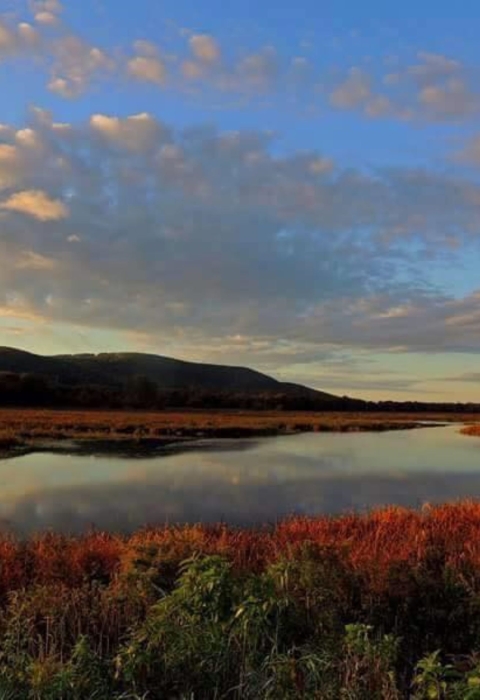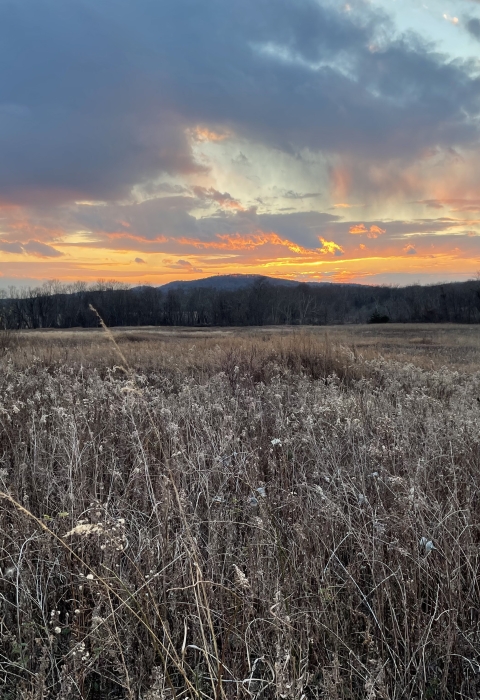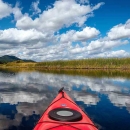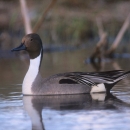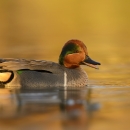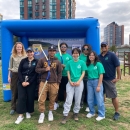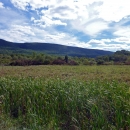Visit Us
The Wallkill River National Wildlife Refuge headquarters is located at 1547 County Route 565, (Glenwood Road), Sussex, NJ 07461. When using a navigational device, enter only 1547 Glenwood Road, Sussex, NJ 07461. Telephone number is 973-702-7266. The Dagmar Dale Nature Trail is located at the Headquarters as well as public bathrooms which are open daily year round. Various environmental educational programs are conducted in and around the refuge headquarters throughout the year.
If interested in visiting the Headquarters building (1547 County Rd 565, Sussex, NJ 07461), it is now open on a by-appointment basis. If you would like to see the small display area or have questions that you would like to ask us in person, please email Jared_Green@fws.gov with the days/times you would be interested in stopping by and we will try to arrange a time that will work for both visitor and staff.
Please note that dogs are only allowed on the Liberty Loop Trail, utilizing the parking lots at Oil City Road or Owens Station Road. All dogs must be controlled on a leash at all times. Service dogs are allowed on all refuge trails and facilities.
Location and Contact Information
About Us
The Wallkill River National Wildlife Refuge consists of amenities such as a headquarters building, visitor contact station, fishing dock, canoe/kayak launch, two outdoor restrooms and an indoor archery range, as well as a variety of hiking trails.
What We Do
Wildlife conservation is at the heart of the National Wildlife Refuge System. It drives everything on U.S. Fish and Wildlife Service lands and waters managed within the Refuge System, from the purposes for which a national wildlife refuge national wildlife refuge
A national wildlife refuge is typically a contiguous area of land and water managed by the U.S. Fish and Wildlife Service for the conservation and, where appropriate, restoration of fish, wildlife and plant resources and their habitats for the benefit of present and future generations of Americans.
Learn more about national wildlife refuge is established to the recreational activities offered to the resource management tools used. Using conservation best practices, the Refuge System manages Service lands and waters to help ensure the survival of native wildlife species.
Our Organization
The U.S. Fish and Wildlife Service is the premier government agency dedicated to the conservation, protection, and enhancement of fish, wildlife and plants, and their habitats.We are the only agency in the federal government whose primary responsibility is the conservation and management of these important natural resources for the American public.
Our Species
Wallkill River National Wildlife Refuge was established to conserve and enhance populations of wildlife and their habitats, to protect and enhance water quality, and to provide opportunities for wildlife-dependent recreation and research. The refuge conserves the biological diversity of the Wallkill Valley by protecting and managing land, with a special emphasis on forest-dwelling and grassland birds, migrating waterfowl, wintering raptors, and endangered species. The North American Waterfowl Management Plan identifies the Wallkill River bottomlands as a priority focus area for waterfowl management within New Jersey.
Get Involved
Whether you want to further conservation, learn more about nature or share your love of the outdoors, you’ve come to the right place. National wildlife refuges provide many opportunities for you to help your community and fish and wildlife by doing what you love.
National wildlife refuges partner with volunteers, youth groups, landowners, neighbors and residents of urban and coastal communities to make a lasting difference.
Find out how you can help make American lands healthier and communities stronger while doing something personally satisfying.
Volunteers: Gain new experiences and meet new people while helping to advance wildlife conservation.
Friends: Join neighbors in helping refuges restore habitat and expand access to green space.
Landowners: Learn how you can partner with the Fish and Wildlife Service to voluntarily restore land.
Local Groups:
Find out how communities can work with refuges better for wildlife and people.
Youth: Explore paid and unpaid opportunities to learn and develop leadership skills.
Projects and Research
The Wallkill River National Wildlife Refuge features a variety of habitats (floodplain forests, grasslands, wetlands) that host a variety of wildlife (freshwater turtles, grassland birds, waterfowl). Our research, project, and initiatives are centered around maintaining and improving these habitats and studying the wildlife present.
